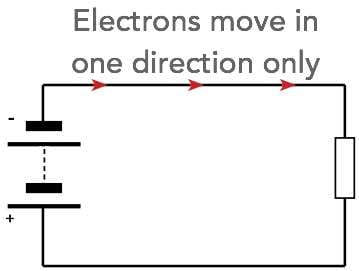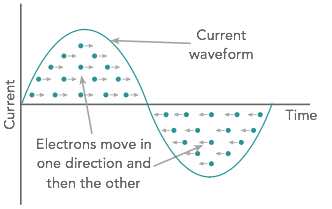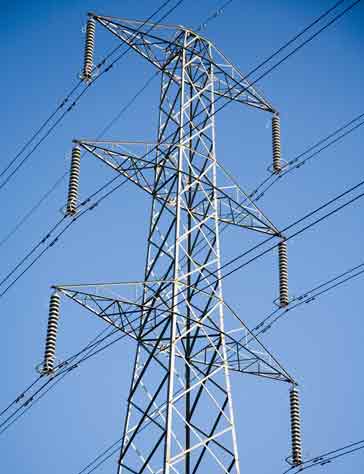Alternating & Direct Current: AC DC Electricity
Alternating current, AC and direct current, DC are two forms of electric current that are used each with its own advantages and disadvantages. Deciding AC vs DC depends on the application and properties of AC and DC.
Electric Current Tutorial Includes:
What is electric current
Current unit - Ampere
AC & DC
One of the major distinctions in the type of current flow in a circuit is whether the current is an alternating current, AC, or direct current, DC.
AC & DC electricity are both widely used in electrical and electronic circuits, each being used for different purposes.
Both AC and DC have their own characteristics and provide different advantages that can be used in different situations.
Video Describing AC & DC
What is direct current, DC
As the name implies direct current, DC is a form of electricity that flows in one direction – it is direct and this gives it its name.

The characteristic of direct current, DC can be shown on a graph. Here the current can be seen to be seen to be either positive or negative only.

Applications direct current, DC
Direct current, DC is used in very many areas:
- Batteries: Batteries, both non-rechargeable and re-chargeable can only supply direct current. The rechargeable batteries also need recharging using direct current.
- Electronic equipment: All equipment like computers, radios, mobile phones, and in fact all electronic equipment uses direct current to power the electronic circuits. Bipolar transistors, FETs and the integrated circuits that use these components all need direct current to power them and will damaged if a reverse polarity is supplied. Although many of these items are powered by AC mains, there is a unit called a power supply within the unit that converts the incoming AC to direct current with the right voltage(s) within the electronic item.
- Some electrical equipment: Although a lot of electrical equipment uses AC, some uses direct current.
- Solar panels: Solar panels used for generating electricity produce direct current directly from the solar panels themselves. When used with AC mains to feed into the mains or supply local AC power for AC supplies, a unit known as an inverter is required to enable the direct current, DC from the solar panels to be converted to AC.
What is alternating current, AC
Alternating current, AC is different to direct current. As the name implies, it flows first in one direction and then the other.

The graph above shows the current waveform varying as a sine wave, with the current first moving in one direction and then the other.
Often it is more usual to see the voltage variations. Again for an alternating waveform the voltage will vary positive and negative.
It can be seen for both current and voltage that the waveform varies becoming, in this example, first positive and then negative.

The sine wave is easy to present and understand, but a wide variety of other waveforms can also constitute an alternating waveform with alternating current.
There are a few salient points about alternating waveforms. The first is the time period for the waveform. This is the time from a point on one cycle of the waveform to the identical pint on the next cycle. Often the peak is the easiest to see as shown, but any point may be taken - for example when a particular voltage is reached in a given direction - this may a voltage trigger point, etc. Zero crossings are another easy point to identify.
Another point about an alternating waveform is its frequency. This is the number of times a given point on the waveform is seen within a second and it is measured in Hertz, Hz where 1 Hz is one cycle per second. The example shown has a frequency of 3 Hz as three cycles are seen within a second.
As other examples, mains power has a frequency of either 50 Hz or 60 Hz dependent upon the country. Europe and many other countries use 50 Hz, whereas North America, Caribbean, and some South American countries use 60 Hz.
Alternating current applications
Alternating current tends to be used for power distribution. It has the advantage that it can easily be converted to other voltages using a simple transformer - transformers do not work with direct current.If power is distributed at a high voltage then the losses are much lower. Take the example of a 250 volt supply carrying 4 amps and a 1 Ω wire resistance. As power, watts = volts x amps, the power being carried is 1000 watts. The power loss is I2 x R = 16 watts.

If a voltage line is carrying 4 amps but has a voltage of 250 000, volts, i.e. 250 kV, and the line is carrying 4 amps, then the power loss is still the same, but the overall transmission system is carrying 1 MW and 16 watts is an almost negligible loss.
It is for this reason that high voltages are used for power transmission, and then reduced to a relatively safe level for use within domestic and commercial properties.
In view of the fact that alternating current is used for the supply system, it is also used in motors, for heating and for many other items without the need for it to be converted to direct current.
AC vs DC
In many areas there can be a decision to be made of AC vs DC and which form of supply is best for a given application.
Alternating current, AC and direct current, DC both have their advantages and disadvantages, but this means that there is a choice to select the best option for any given use or application. Alternating current, AC is generally used for power distribution, which is why the mains sockets in our homes and at work provide an alternating current to power whatever is needed, but direct current, DC is more widely used for the electronics boards themselves and for many other applications.
Both alternating and direct current supplies are both widely used across the electrical and electronics industries, each in their own areas of benefit.
Both AC and DC are able to provide electrical power transfer, but with slightly different benefits.
 Written by Ian Poole .
Written by Ian Poole .
Experienced electronics engineer and author.
More Basic Electronics Concepts & Tutorials:
Voltage
Current
Power
Resistance
Capacitance
Inductance
Transformers
Decibel, dB
Kirchoff's Laws
Q, quality factor
RF noise
Waveforms
Return to Basic Electronics Concepts menu . . .



